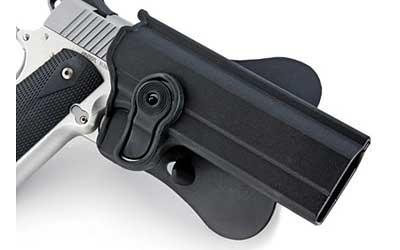What to Look For in a Gun Holster
What do a guitar, a gun and a cell phone have in common? They are all pretty important to the owner, they’re all possibly something quite expensive and they all require some degree of protection from being damaged or being separated from their owner.
In the case of the gun, a holster provides weapon protection and is a convenient way of carrying it or concealing it. It also adds a measure of safety for you and others so that the gun doesn’t fire accidently.
There are a number of considerations in choosing the type of holster, for instance what is your purpose in carrying gun? Are you a security guard, a probation officer, a sheriff or anyone else that carries a gun as part of their job? Or maybe you carry it for personal protection?
A gun sometimes needs to be withdrawn from its holster quickly. Other times you might be in a position where you want to avoid the possibility of someone else trying to forcibly remove the gun from your holster, for instance a policeman moving through a crowd. Both of these involve a holster with different retention types of properties.
The more security measures a gun holster has to stop the gun being removed the more retention properties it is said to have. So for instance a level 1 has one retention device and a level 4 has 4 different devices that determine how the gun is released from its holster. An old west gunslinger probably had no retention devices on his holster, as the speed of the removal of the gun was a big factor in how successful he was and how long he lived.
Those devices can be a screw, which can be tightened making the holster fit more snuggly to the gun. It could also be a thumb snap that fits over the rear sight or hammer area. It may be an internal locking device that is activated from outside the holster or some other locking mechanism that requires pushing the gun further into the holster to release it. All those mechanisms again determine the retention number and how easy or difficult it is to remove the gun.
Lets compare two holster types that DNA carries from the HOGUE and Sig Sauer product lines.
A "Duty Holster" quite simply means a holster designed to carry say an officer's duty weapon. It can however also refer to a holster that has a particular design style or the material it is made of. A duty holster will often be made of leather, a leather weave, kydex, carbon fiber, plastic or nylon.
A Paddle Holster by comparison is a handgun holster that is attached to a belt or pants waistband by sliding a flat, concave shaped piece of plastic (shaped like a paddle) onto the belt. The gun will stick out a little further if worn on the outside of the pants and may actually be more comfortable but if concealment is a factor then it can also be worn on the inside of the belt. It may be made of a variety of materials but most often a polymer or stiffened leather. The holster with gun enclosed can be removed easily by just lifting it off the belt or if preferred it also provides the friction to remain attached to the belt when the gun is drawn. It can be slid forward or back along the belt easily.
You may see someone with this type of holster at an airport or any kind of security stop where the firearm wearer is required to take it off, it comes off easily and quickly.
The primary benefit of this style of holster is that the entire holster and firearm can be removed from the wearer for convenience, for instance when they are sitting or changing outfits.
Choose your holster carefully its protecting one of your greatest assets.
